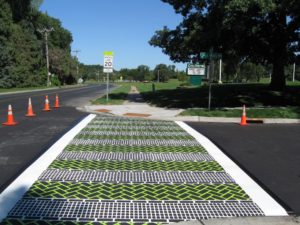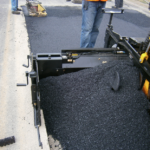Pedestrian Crossing Design
 Pedestrian crossing needs to be designed carefully in order to provide safety, not only for the pedestrian but also for the other road users. Safe and frequent pedestrian crossings support a walkable environment. Herewith categories that need to be considered in designing pedestrian crossing.
Pedestrian crossing needs to be designed carefully in order to provide safety, not only for the pedestrian but also for the other road users. Safe and frequent pedestrian crossings support a walkable environment. Herewith categories that need to be considered in designing pedestrian crossing.
- The location
Install a pedestrian crossing where there is a significant pedestrian desire line. Frequent applications include mid-block bus stops, metro stations, parks, plazas, monuments, or public building entrances.Pedestrian crossings can be located at an intersection or mid-block. Provide pedestrian crossings at all legs of intersections.
- The spacing
It is necessary to provide level crossings every 80–100 m in urban environments. Distances over 200 m should be avoided, as they create compliance and safety issues. He or she may decide to cross along a more direct, but unsafe route if it takes a person more than three minutes to walk to a pedestrian crossing,
- Signalisation
Where vehicle speeds are above 30 km/h and pedestrian volumes and crossing demands are moderate to high, provide signalized crossings to support a safe walking environment.Uncontrolled crossings are generally safe on streets with low traffic volumes, and speeds below 30 km/h.
- Visibility and daylighting
It is important to provide adequate waiting areas for pedestrians to see oncoming traffic and increase visibility for drivers by adding curb extensions or refuge islands.Restrict parking or install curb extensions in order to make pedestrians more visible to motorists and cars more visible to pedestrians.
- Length (crossing distance)
Keep crossing distances as short as possible using tight corner radii, curb extensions, pedestrian refuge islands, and medians.Medians and refuge islands create a two-stage crossing for pedestrians, which is easier and safer when crossing multiple lanes of traffic.
- Width
A pedestrian crossing should be at least as wide as the sidewalks it connects to and not be less than 3 m wide.
- Marking
Always mark the pedestrian crossing, regardless of the paving pattern or material. High-visibility ladder and zebra markings are preferable to parallel or dashed pavement markings. These are more visible to approaching vehicles and have been shown to improve yielding behavior by drivers.
Pedestrian Crossing
The presence of a pedestrian crossing does not alone render a street safe. Based on pedestrian and traffic volumes, speed, and roadway width and configuration, pedestrian crossings may require additional safety measures such as refuge islands, signals, or traffic calming strategies.
Contact us
 Phone Call |
 Text Message |
 |







